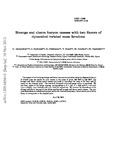Strange and charm baryon masses with two flavors of dynamical twisted mass fermions
| dc.contributor.author | Alexandrou, C | |
| dc.contributor.author | Carbonell, J | |
| dc.contributor.author | Christaras, D | |
| dc.contributor.author | Drach, V | |
| dc.contributor.author | Gravina, M | |
| dc.contributor.author | Papinutto, M | |
| dc.date.accessioned | 2018-07-25T15:39:29Z | |
| dc.date.available | 2018-07-25T15:39:29Z | |
| dc.date.issued | 2012-12-03 | |
| dc.identifier.issn | 1550-7998 | |
| dc.identifier.issn | 1550-2368 | |
| dc.identifier.other | 114501 | |
| dc.identifier.uri | http://hdl.handle.net/10026.1/11918 | |
| dc.description | 19 pages, 18 Figures. Typos corrected, reference added, version to appear in Phys. Rev. D. arXiv admin note: text overlap with arXiv:0910.2419 | |
| dc.description.abstract |
The masses of the low-lying strange and charm baryons are evaluated using two degenerate flavors of twisted mass sea quarks for pion masses in the range of about 260 to 450MeV. The strange and charm valence quark masses are tuned to reproduce the masses of the kaon and D meson at the physical point. The tree-level Symanzik improved gauge action is employed. We use three values of the lattice spacing, corresponding to β=3.9, β=4.05 and β=4.2, with r0/a=5.22(2), r0/a=6.61(3) and r0/a=8. 31(5), respectively. We examine the dependence of the strange and charm baryons on the lattice spacing and the strange and charm quark masses. The pion mass dependence is studied and physical results are obtained using heavy-baryon chiral perturbation theory to extrapolate to the physical point. © 2012 American Physical Society. | |
| dc.format.extent | 114501- | |
| dc.language | en | |
| dc.language.iso | en | |
| dc.publisher | American Physical Society (APS) | |
| dc.subject | hep-lat | |
| dc.subject | hep-lat | |
| dc.subject | hep-ph | |
| dc.subject | nucl-th | |
| dc.title | Strange and charm baryon masses with two flavors of dynamical twisted mass fermions | |
| dc.type | journal-article | |
| dc.type | Journal Article | |
| plymouth.author-url | https://www.webofscience.com/api/gateway?GWVersion=2&SrcApp=PARTNER_APP&SrcAuth=LinksAMR&KeyUT=WOS:000311807900008&DestLinkType=FullRecord&DestApp=ALL_WOS&UsrCustomerID=11bb513d99f797142bcfeffcc58ea008 | |
| plymouth.issue | 11 | |
| plymouth.volume | 86 | |
| plymouth.publisher-url | http://dx.doi.org/10.1103/PhysRevD.86.114501 | |
| plymouth.publication-status | Published online | |
| plymouth.journal | Physical Review D | |
| dc.identifier.doi | 10.1103/physrevd.86.114501 | |
| plymouth.organisational-group | /Plymouth | |
| plymouth.organisational-group | /Plymouth/Faculty of Science and Engineering | |
| plymouth.organisational-group | /Plymouth/Faculty of Science and Engineering/School of Engineering, Computing and Mathematics | |
| plymouth.organisational-group | /Plymouth/REF 2021 Researchers by UoA | |
| plymouth.organisational-group | /Plymouth/REF 2021 Researchers by UoA/EXTENDED UoA 10 - Mathematical Sciences | |
| plymouth.organisational-group | /Plymouth/REF 2021 Researchers by UoA/UoA10 Mathematical Sciences | |
| plymouth.organisational-group | /Plymouth/Users by role | |
| plymouth.organisational-group | /Plymouth/Users by role/Academics | |
| dc.identifier.eissn | 1550-2368 | |
| dc.rights.embargoperiod | No embargo | |
| rioxxterms.versionofrecord | 10.1103/physrevd.86.114501 | |
| rioxxterms.licenseref.uri | http://www.rioxx.net/licenses/all-rights-reserved | |
| rioxxterms.type | Journal Article/Review |


